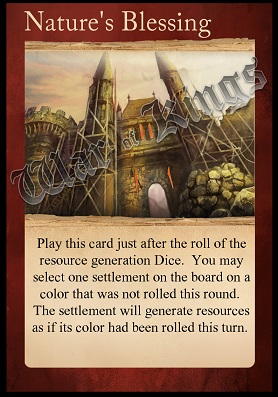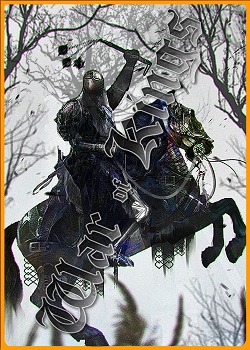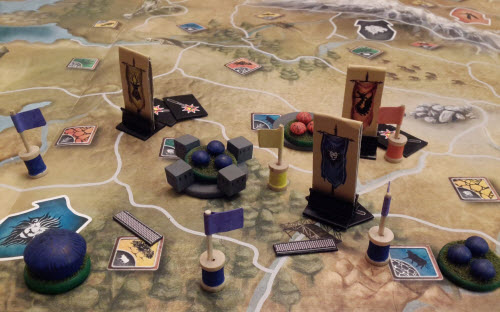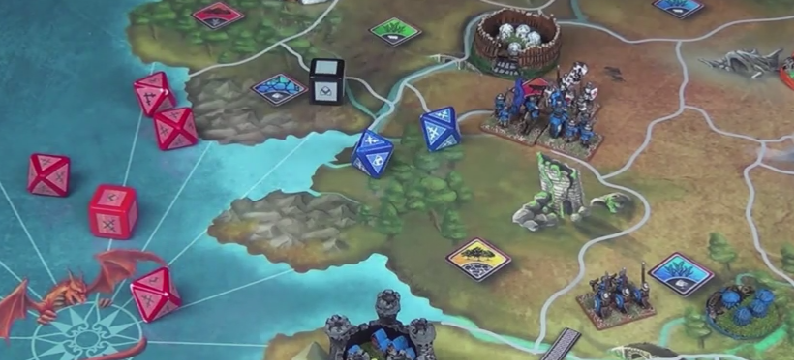The king is dead, and he has not left a suitable heir. Until a new king is determined, the entire region will continue to grow more unstable. Projects go unfinished, taxes go uncollected, and barbarians now freely cross beyond the borders that have kept them at bay for so long. In these difficult times you know in your heart of hearts that you alone are the one to reunite the kingdom. You have a [mostly] legitimate claim to the throne, and you feel that can truly save this troubled land.
Now if all those other people doing the same thing would kindly move the hell out of the way, it’d make your job a whole lot easier. It’d be much more preferable if they just stepped aside and let you won, rather than fight a series of bloody campaigns, but they stubbornly refuse for some reason. Whatever; it’s their funeral.
Hopefully…
Such is the situation you have been tossed into as you begin the War of Kings, a strategy game of royal succession.

Choose your loyalty carefully.
Prototype Shown
Right out of the gate, it’s evident with War of Kings that you are in for a solid gaming challenge. There is a lot to take in with War of Kings, and while it can appear pretty daunting at first…well alright, it’s actually going to be a little daunting at first. There is a bit of a learning curve the first time around. However, having options aren’t necessarily a bad thing, and once explained, War of Kings proves to be remarkably straightforward, challenging, and entertaining.
The Rules of War
War of Kings is expansive; the board is segmented into a number of territory spaces. Each territory has a color-coded resource box, consisting of one of four resources. Players each start out with four of those territories to begin the game, making up your personal holdings. Throughout the game, you conquer new territory and can building settlement them. Settlements in War of Kings come in three stages: village, town, and city.
To show that you’re at least somewhat competent of a ruler, each player begins with a town, a village and some starting resources.
Higher stage settlements provide a number of benefits, including more VP, more resource gathering, and a better defense when someone comes ‘a knocking. Players can also build defense for their settlements in the form of walls, fortresses and castles. Moreover, as your kingdom grows, it also becomes essential to build roads between these settlements, as it helps in army movement and in generating gold for your kingdom.
Rounds in War of Kings play out over six phases. The first phase is Construction, and everyone does this simultaneously. One player rolls three colored Resource dice, and everyone collect the resulting resources of those colors from territories they control. Having settlements on those territories provide even more resources. (So just having a territory with a Red symbol gives you one of that stated resource, for example, while having a village on that space gives you two. You know, because more people and such.) Players also collect their kingdom’s gold income for the round, which is determined by how many of your settlements are linked to your capital by road. Then, players are free to trade, barter, and build whatever they can afford, taking just a handful of restrictions into consideration when doing so.

Prototype Shown
Once everyone is done warmongering, the active player begins their turn by rolling a Resource die and the Event die, which lists either a settlement type or Marauder colors. If the player has that settlement on that color territory, they draw an Event card – powerful utility cards that can help with many different facets of the game – to be used later. Cards like this:
If, however, the event die comes up Orange (apparently the color of evil in this kingdom), the player instead reveals a Marauder card. Marauders represent a neutral barbarian faction in the kingdom, and their impact on the player can be quite unpredictable.
Then comes the mustering of the troops. The player can sending them to potentially explore new land or fight some enemies. If an army is taking over neutral territory, the player draws and resolves a Discovery card to see if they’re successful. If not, it’ll tell you. (Did you really expect to be able to simply walk in and take over every new territory unchallenged? Perhaps you aren’t fit to be king after all…)
On the other hand, if an army is in conflict with the Marauders or another player, combat ensues. Combat in War of Kings is pretty simple, with players each rolling a set of dice to determine battle damage, and things like army number superiority and settlement defenses add additional dice to the equation. If the resulting number of attacker dice with sword icons is greater than the defender’s shield icons, then the defender takes damage. However, reflecting the ebb and flow of battle, the defender then counterattacks with another set of rolls. After one such volley, if neither side (or both sides – it’s not uncommon) have lost their army units, then combat is over. If both factions remain, though, there is an opportunity to potentially withdraw. Otherwise the fight continues until someone has left broken and bloody stains upon the cold hard ground. It’s war, people.

A Marauder card.
Prototype Shown
Lastly, there is the Supply phase, which allows a player to pay to essentially heal army units that didn’t move this round and have access to a town, illustrating that the game is not simply an all-offense all the time system. Then the next player starts their assault upon the land, in their feeble attempt at the throne.
When everyone has taken their turn, the round begins anew. War of Kings continues until one or more players can claim they have 13 achievement points at the end of a round, which is done by having a combination of settlement types and various ‘Meet This Condition’ styled objectives that can be stolen away from one another.
To Rule Like Kings
Ostensibly, War of Kings gives you a decent amount of information in fairly short order and then asks you to to dive right in. By all outward appearances, it seems like it’s your standard ‘war game with minis’ fare with a complicated rules system – it does have a handful of charts to reference after all. However, War of Kings may not be entirely what it seems. Indeed, it has a number of things that make it a uniquely rewarding experience to play, including:
- It’s not an elimination game per se: Yes, it’s possible that you can simply off your opponent’s head, but the game is more about controlling territory and getting VP than having to destroy everyone so utterly and completely that their names are lost to time.
- Simultaneous Upkeep: There is a lot that happens during the Construction phase via gathering gold, resources, and building units. Even with a provided sheet to help track your resources from round to round, surmising what your move is every round takes time. War of Kings wisely lets everyone do this at the same time. It’s already going to be a fairly long game, and this keeps the game moving along at a manageable pace.
- The Marauders: It almost seems counterintuitive to add a neutral faction to a game that seemingly has so much else going on already, but the Marauders can be a refreshing wild card to many situations. Sure, they’re just as likely to be beneficial to you as to be completely detrimental, but this fact is true for all players. It helps keep players on their toes and can also be a check against people expanding too fast.
- Cultural Ownership: This is arguably one of the best mechanics in War of Kings, even if minor. When conquering a territory with an opponent’s settlement, there’s you now control that land. Those settlements are under your control, and they’ll count for status and resource gathering. But their hearts will always lie with the player who built them. If that player reconquers that territory, the settlement will not resist. And there’s nothing you can do about that, unless you burn the settlement to the ground. Which, you know, is also an option.
Many people will also be enamored with the game pieces themselves, and they do add extra gravitas to the game. There’s a real sense of accomplishment and security when you’re able to put up a fortress around your town, for instance. However, this isn’t exactly a minis-centric game, nor does it behave like combat simulation war games. At its core, gameplay in War of Kings is closer to an Area Control version of Settlers of Catan – albeit a Catan turned up to 11. The randomness to resource generating and the luck factor of certain dice rolls adds a lot of variance to a game that would otherwise become mired in repetitive action, but it allows War of Kings to have an epic feel to the game without having all of the rules complexity and incredibly lengthy game sessions that epic games generally have.

Things did not go well for the Blue player.
Prototype Shown
Mind, you War of Kings is still not a minor affair, and that is evident. War of Kings thrives off of working towards your objectives and competing with other players for valuable territory. As a result, while the game is slated for 2-6 players, we highly recommend playing with four or more. Between the upkeeep on rounds and the emphasis on securing territory, it can have difficulty reaching its full potential with less than that. But finding people who’d like to rule the land shouldn’t be difficult, right? After all, who wouldn’t want to be king?
If you think you have what it takes to stand up to marauders, logistics, and wannabe usurpers, then take up the gauntlet, saddle up your steed, and join the fray that is the War of Kings – currently over on Kickstarter.

